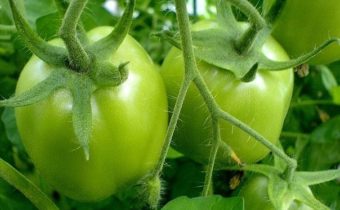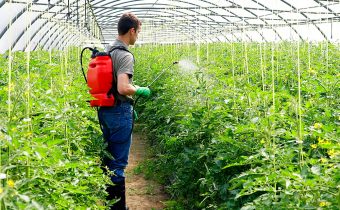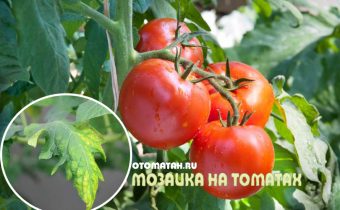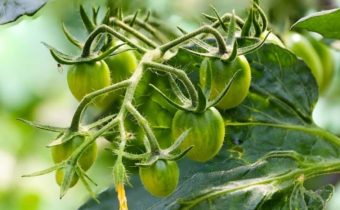How to feed seedlings with iodine

More recently, in the agricultural stores to find drugs containing iodine, it was impossible. Today, such fertilizers appear, but many in the old manner prefer to use ordinary iodine, which is in every home medicine chest. How to use it for seedlings of peppers and tomatoes, as well as why it is needed by these plants and what options there are fertilizing, consider next.
Why iodine
Iodine is needed for almost every biological process. For plants that are planted on black soil and chestnut soils, it is sufficient, but salt marshes, sierozems and podzolic soils are deficient in this substance.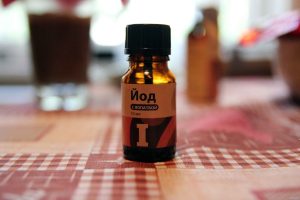
Regular iodine top dressing is recommended on poor depleted soils. It replaces many nitrogenous fertilizers. And with foliar use stimulates the metabolic processes of plants at the cellular level.
If wood ash or phosphate rock is used for the kitchen garden, a sufficient amount of iodine is already supplied, so additional procedures are not necessary.
The use of iodine to feed plants contributes to:
- increase in fruit weight by at least 20%;
- more active seed germination;
- immunity increase;
- more abundant harvest;
- death of fungi and infections;
- plant resistance to weather extremes and pest attacks.
For feeding plants iodine gives the greatest effect during the preparation of seeds for sowing and during the cultivation of seedlings.
Feeding rules
Before planting can be any seeds that have passed the selection. Only hybrid touch not worth it. The pellets in the shell are already provided with all the substances necessary for development, and by intervening, you simply nullify all the work of breeders.
Seedlings should be fed only if it is deficient in iodine. Signs of that are like starvation. First of all it is: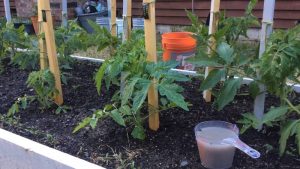
- blanching the above-ground part of the seedlings;
- excessive stretching of the stems;
- withering.
With these signs, you can spend one dressing and wait 10 days, if the condition of the plants does not improve, reinforce the effect with the help of saltpeter or mullein.
The concentration of iodine in the solution for each plant, as well as the purpose of processing is different. Therefore, every gardener needs to know at least a few ways.
Types of iodine dressing
Iodine treatment is carried out:
- when soaking seeds;
- for root feeding;
- for foliar top dressing.
Soak
Soaking in iodine solution is used for disinfecting seeds and entering them in quantities sufficient for normal development.
For this, three drops of iodine are added to three liters of water. Seeds are immersed in the solution for 5-6 hours, you can overnight, and then washed and proceed to further preparation for planting (hardening, germination, etc.).
Root dressing
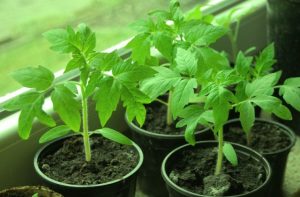 Under the root of the iodine solution can be made only once. This dressing increases the stability of the seedlings and its immunity, protects against fungi and pests.
Under the root of the iodine solution can be made only once. This dressing increases the stability of the seedlings and its immunity, protects against fungi and pests.
The solution is prepared in the proportions of 1 drop per three liters of water. Watering should be carried out in the early morning or in the evening after sunset around the stem, it is dangerous to touch the above-ground part of the plant and fall on the still weak roots.
Foliar top dressing
Foliar nutrition for seedlings is also important, especially if it is grown in greenhouses. High humidity contributes to the development of fungal infections, and iodine sprays are a great way to prevent.
They can also be used as part of complex treatment to reduce the activity of pathogenic microflora and prevent the spread of spores.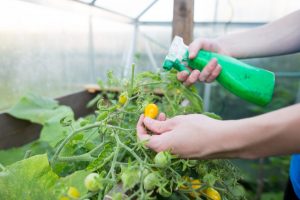
To prepare a solution in 10 liters of water dissolve 3-5 drops of iodine, depending on the age of the plant.
There are differences in iodine supplementation and depending on the type of culture.
Top dressing of seedlings of tomatoes
Tomatoes iodine is needed to increase yields, improve the quality of fruits and their visual appeal, but you can only do this dressing once. And it does not hurt to conduct dressing for healthy shoots.
The solution is prepared from the calculation of a drop of iodine in 3 liters of water. Watering is carried out with the appearance of the second true leaflet on the seedlings.
Re-root iodine top dressing of tomatoes is carried out after transplantation into the ground, when ovaries are formed. This time the solution should be more concentrated. 3-4 drops of iodine are taken for 10 liters of water. For stunted under one bush 600-800 ml is enough, and for tall ones you need at least a liter, and preferably 1200 ml under one bush. Pre-tomatoes are also better to pour, so that the next day do not water.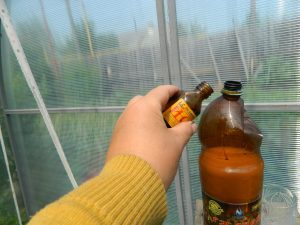
The third dressing is carried out at the very beginning of fruiting. In addition to iodine, wood ash is added to the solution. The solution is quite concentrated.
In 5 liters of water it is necessary to insist a few hours three liters of ash, then pour in a 10 ml vial of iodine and boric acid. The resulting mixture should be mixed with five liters of water, mix well and bring under the root of 300-500.
Feeding seedlings pepper
Pepper, like tomatoes, belongs to the nightshade, so the feeding scheme is very similar to that used for tomatoes:
- seeds are soaked in a solution of 3 drops of iodine per 3 liters of water;
- with the appearance of the second leaf, root dressing is carried out with a solution of iodine drop to three liters of water;
- at the stage of formation of the ovaries, root dressing is carried out with infusion of wood ash;
- During the fruiting period, root dressing is carried out using infusion of ash with the addition of iodine and boric acid.
Also note the recipes for the following iodine solutions:
- If seedlings of pepper or tomatoes are infected with blight, you can prepare a solution of a liter of serum, 40 drops of iodine and a table. peroxide spoons. Mix everything and spray the leaves.
- From all types of spotting helps such a solution - a liter of milk + 15 drops of iodine + 15 g host. soap + 4 liters of water. It is necessary to spray late in the evening.
- To activate the strength of the seedlings need to make iodine yeast solution. To do this, 200 grams of fresh yeast is dissolved in a liter of warm water and allowed to brew for 3-5 hours, then diluted in 10 liters of water and 2 drops of iodine are added. Water under an adult plant 300 ml for pepper and 500 ml for tomato.
Working with iodine requires compliance with safety measures and especially when processing plantings in greenhouses. The fact is that even with low concentration, falling into the respiratory system, the solution can cause severe burns of the mucous membrane. It is always necessary to work with the prepared solutions in rubber gloves, glasses and a respirator.


